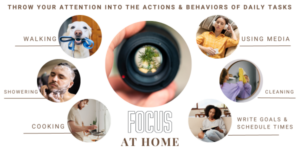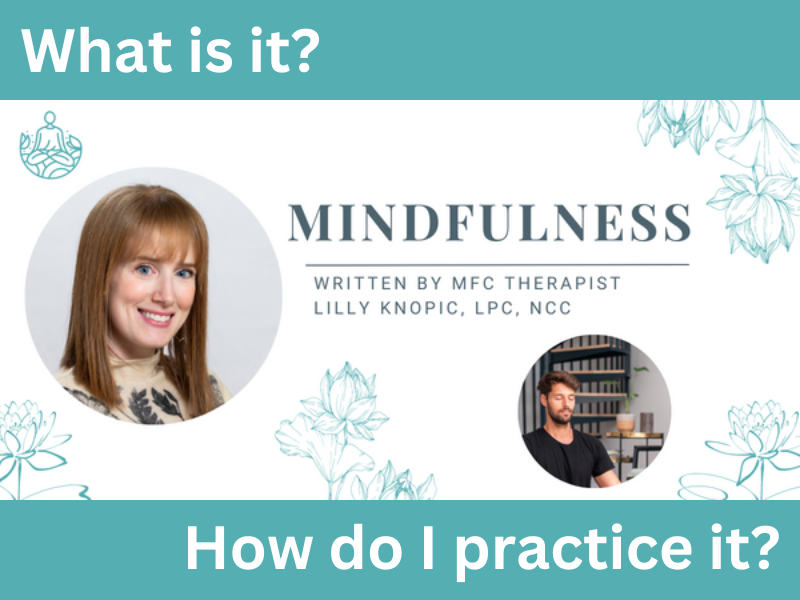Mindfulness
An Article by Lilly Knopic, LPC, NCC
In my living room, the lamp is in the furthest corner from the exit. When it is time to retire for the night, and thus the TV turns off, it can be pretty annoying to turn off the lamp and cross back through the living room in darkness. I may drop my cell phone, step on toy cars, bump my knee on the end table, and at the very least, I move slowly as I guide my way using touch, avoiding the challenges above.
Making It Through
Moving through the darkness takes time. Can I make it through? Yes. Do I survive? Yes, of course. And at the same time, is it more effective to have a light shining on the obstacles? Yes. That is the definition of mindfulness. Navigating life’s obstacles with the light turned on is more effective. When I first heard a version of this analogy, I appreciated its communication of the “why” behind mindfulness, especially as a foundation for thinking and acting more dialectically (seeing both sides). If I’m encouraged to practice something, change a behavior, or devote time to a skill, I need to know “what’s in it for me.” Why bother? Mindfulness helps us fully experience life as it is happening more effectively.
A Foundational Principal
Mindfulness is a foundational principle of DBT (Dialectical Behavior Therapy). To be most effective at the other skills, mindfulness must be targeted. Although DBT is designed as an evidence-based treatment program for a specific set of symptoms one might experience, many people hear about DBT and find interest in its philosophies due to DBT’s skills of improved emotion regulation. Many of us can relate to the impact of intense or frequent emotions, and thus, DBT is very appealing. Mindfulness is the starting point if one is interested in regulating emotions more effectively. We cannot problem-solve without awareness of the problem or what is influencing the problem (the “light on” analogy). Emotions and thoughts are not bad, but they can cause us problems.
The “How,” “What,” and “Why” of Mindfulness
Before we get into “how” to increase mindfulness in your daily life, here are a few more sentiments about “what” so you can develop your own “why.” Mindfulness teaches us to bring our attention and focus to the present moment as much of the time as we are able. When we visit the past or future, the emotions associated with these spaces can arise, which is only sometimes helpful or convenient. If we spend time in the past or the future, mindfulness will prompt us to do so intentionally and with full awareness; what are we learning or gaining from visiting these thoughts?
Observing and Noticing
Another goal of mindfulness is to observe and notice, which pulls information into our brains and is essentially the foundation for change (“getting feedback”). Also, we practice mindfulness to connect with what is real, factual, and happening in the current moment. On my journey, I also found it helpful to understand what mindfulness is “not.” Mindfulness is not just relaxation. It is not an escape. It is not about “getting it all together.” And the goal is not to remove emotional reactions. The goal is to become more aware, present, participatory, intentional, and alive in each moment.
Starting your Mindfulness Practice
It can be overwhelming to engage in any new routine, so I wanted to share my preferred ways to practice mindfulness daily, especially on days when it would feel impossible to add another task or chore to my schedule:
- Create an awareness trigger: Pick 1 task or event that is likely to happen a few times a day (receiving an email, seeing a specific color, the act of sitting down) and use this as your prompt to “notice” and practice mindfulness, such as a few deep breaths or a grounding technique you enjoy.
- Listen attentively to another person in your day: let go of the need to respond; observe words you are saying, and they are saying; explore being present with them.
- “I like”: when you notice something you like, say to yourself (noting in your mind or out loud), “I like [insert what you observed].” This strategy works well if you take a mindful walk (inside or outside) or even when scrolling on social media. Fully participate in your social media time to prompt positive emotions.
- Practice mindfulness at bedtime: Notice your head hitting the pillow, your body resting, and take a few deep breaths.
- Observe helpful or positive emotions: “I notice a sensation of strength,” “I observe that I feel energized today,” “I observe that I feel centered.”
- Observe colors: Start by thinking of a color; can you observe or find it in your space? Throw your attention on that object as though it were a spotlight. Keep going. Go through the rainbow and do a “color scavenger hunt” on a walk.
- Try “One-mindfulness:” This DBT-inspired skill asks us to participate fully in the moment by using our five senses.
- Fully throw your attention into a task’s actions/behaviors and observations. Showering, cleaning, cooking, or “mindful” media are effective activities to try this strategy. What do you feel? What are the details you notice? You might need to bring your attention back to the task again and again and again.

How to Increase Your Skill
Let’s acknowledge that many new behaviors are less comfortable and challenging compared to what we are currently doing. Below are a few of my thoughts on increasing any behavior or skill that is new to your life:
- Identify and acknowledge what is hard about practicing mindfulness
- Schedule time to practice in your calendar, as you would an appointment or another obligation.
- Reward yourself: set a SMART (specific, measurable, attainable, realistic, time-oriented) goal and reward yourself for completed action items and progress. Ask your therapist for help with some ideas.
- Schedule a “moment to pause:” check-in with yourself three times daily (a check-in can simply be a deep breath and then noticing thoughts/urges/needs)
- Identify your “why:” how do these concepts relate to YOUR goals? How would you benefit from living more mindfully? (these are great journaling prompts!)
The Benefit of Mindfulness
If we can begin to add strategies that try to decrease unwanted emotions, such as noticing judgments, or increase more helpful emotions, such as fully participating in pleasant events, maybe a morning, or even a day, feels less challenging. A mindful moment to pause and “just notice” can create opportunities for our wellness, relationships, and goals. I hope you can incorporate some of my mindfulness suggestions into your daily life.




























